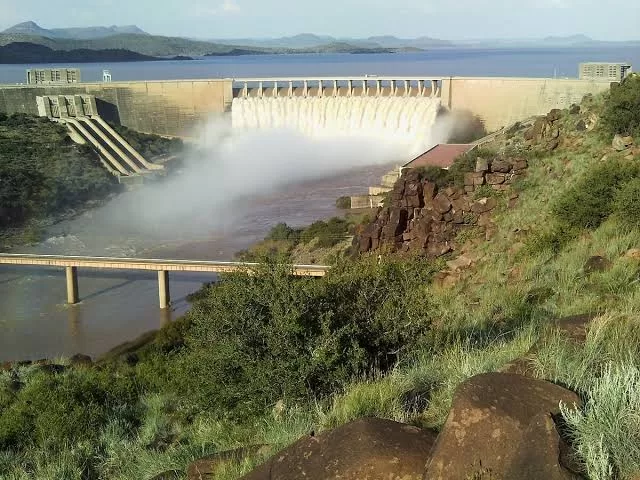The update on the Grand Ethiopian Renaissance Dam (GERD)came during a cabinet meeting led by Prime Minister Abiy Ahemed, who has spearheaded the project as vital to the nation’s development.
According to a statement from the Prime Minister’s office, the government considers the GERD’’ one of the most important strategic infrastructure projects in the country ‘’that will significantly boost Ethiopia’s electricity generation and enable energy exports to neighbouring countries.
Also read: Africa’s biggest Dam Grand Ethiopian Renaissance begins Fifth Turbine Power Generation
Project Factsheet
Location: Guba, Benishangul-Gumuz Region, Ethiopia, approximately 30 km upstream of the border with Sudan.
Purpose: Primarily for hydropower generation to address Ethiopia’s energy shortage and export electricity to neighboring countries. It is a non-consumptive project aimed at easing water scarcity.
Construction began: April 2, 2011.
Owner and operator: Ethiopian Electric Power (EEP).
Cost: Approximately $5 billion, financed by the Ethiopian people through bonds and contributions.
Dam type: Gravity, roller-compacted concrete.
Main dam height: 155 meters (509 ft).
Main dam Length: 1,780 meters (5,840 ft).
Reservoir name: Millennium Reservoir.
Total reservoir capacity: 74 billion cubic meters (60,000,000 acre⋅ft), roughly twice the volume of Lake Mead.
Active reservoir capacity: 59.2 billion cubic meters (48,000,000 acre⋅ft).
Surface area of reservoir: 1,874 km² (724 sq mi).
Power station installed capacity: Initially planned for 5,250 MW, revised to 5,150 MW. This will be the largest hydroelectric power plant in Africa and among the top 20 globally.
Number of turbines: 13 Francis turbines.
Estimated annual energy generation: 15.76 Terawatt-hours (TWh).
Spillways: Three (1 gated with 6 sector gates, 2 ungated) with a gated spillway capacity of 14,700 m³/s (520,000 cu ft/s).
Saddle dam: A rock-filled saddle dam located beside the main dam, approximately 5 km long and 50 m high, with a volume of 16.5 million cubic meters.
Ahmed told parliament in march that a ribbon cutting ceremony would take place in the next six months, marking a“ historic event’’ at the beginning of the Ethiopian new year in September.
Capacity of the Grand Ethiopian Renaissance Dam
The dam, set to become Africa’s largest hydroelectric facility with over 5,000 megawatts of the generating capacity when finished, has been generating power since February 2022. But its progress has fuelled a decade long conflict with downstream nations Egypt and Sudan.
Cairo and Khartoum continue to demand a binding agreement on the dam’s fillings and operation before Ethiopia completes the project. Both nations fear the massive reservoirs, which hold 74 billion cubic meters of water when full, could dramatically reduce their Nile water supply during the filling and drought periods.
Egypt, which depends on the Nile for more than 90% of its freshwater and considers it a matter of national security, could loose up to 10 billion cubic meters of water annually during reservoir fillings. This potential reduction comes as Egypt faces water scarcity levels below international poverty thresholds.
“Any significant reduction in water flow could devastate our agricultural sector and affect drinking water supplies for millions, ‘’an Egyptian water official told this newspaper last month on conditions of anonymity.
Ethiopia, meanwhile, insist the project won’t cause any significant harm to its downstream neighbours. Officials in Addis Ababa argue the dam will actually benefit the region by regulating the flow of water, preventing flooding and reduce siltation.
For Ethiopia where more than half the population lacks electricity access the dam represents both development hopes and national pride. The $4.8 billion project has been largely self funded via government bonds and citizen contributions.
Neighbouring Countries Raise Concerns
February saw Egypt and Sudan issue a join statement following meetings their foreign and irrigation minister, emphasising that water security between the two countries is’ ’an indivisible part of the dam as ‘’ a problem between Egypt, and Sudan Ethiopia’’ that shouldn’t involve other Nile basin countries.
While both downstream nations affirmed their commitment to peaceful solutions, they call on all parties to ‘’refrain from any unilateral action that could harm their water interest.’’
International mediation efforts by the African Union, United States and World Bank have thus fur failed to broker a comprehensive agreement. As Ethiopia approaches the project’s completion, diplomatic pressure is mounting, via analysts say Addis Ababa’s position has strengthened as the dam become an increasingly irreversible reality.
“At this stage with the dam nearly completed, negotiations are shifting from whether it will be built to how it will be operated,’ ’said lama Al-Hajj, a water security expert at the Middle East Institute. “Egypt and Sudan are now focused on securing guarantees for water release during drought periods.’
The next few month will be critical as finalises construction and prepares for official inauguration, while down stream notions continue pressing for operational safeguards that guide their water supply for generations to come.
Also read: Africa’s Largest Hydroelectric Project: The Grand Ethiopian Renaissance Dam Nears Completion


If agreement on the contentious issues is reached and resolution is achieved peacefully, all the three nations will benefit from the GERD. Ethiopia must give guarantees to the neighbours of her commitment to abiding by the resolutions.
Showcases that Funding projects using a countries internal resource is viable .